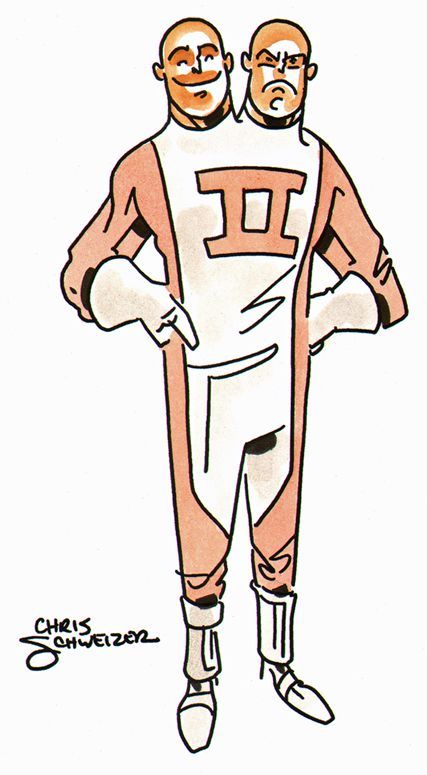Meet Double-Header
Thanks to the generosity of a friend, I got me a copy of the Mutants & Masterminds Deluxe Hero’s Handbook by Green Ronin Publishing, LLC. (Nota Bene: That’s an affiliate link.) It’s a lovely book. Great art throughout, easy-to-read double-column format, et cetera. It’s got some neat stuff, including a spiffy Quickstart Character Generation section, which I’ve used to help me figure out hero creation. The MMDHH is the third edition of Mutants & Masterminds, and it bills itself as “The World’s Greatest Superhero RPG!” It’s not, but it’s still a solid system that I’d love to play, but probably less-than-love to GM.
The first and second editions of Mutants & Masterminds are both too fiddly and too slow (in my opinion) to be a really enjoyable superhero RPG from a GM’s perspective. Those editions aren’t as fiddly and slow as Champions, but few games I’ve played over the past four decades can match Champions in slow fiddliness.
The third edition Mutants & Masterminds resembles the first two editions in big ways at first glance. It’s still sort of a d20 System game, but it deviates from that system enough that it’s closer to its own system than not. It feels like gameplay would be faster than the earlier editions, but only once the differences are learned. I’ve only run a short trial combat with one player to try to get a feel for the new edition. We both had plenty of questions about how to do this, that, or the other thing. Thus, our brief playtest had numerous interruptions, but, like I said, that’s more due to the newness of the edition as compared to what we’re accustomed to with Mutants & Masterminds.
One thing that’s still the same is how much I enjoy making up heroes using the system, and I do think the third edition improves on the earlier ones in this regard. There’s still more math and accounting than I’d normally want to bother with to make up a character, but it’s math and accounting that’s kind of enjoyable. It’s fun to come up with a character concept, to take 150 points, and then to figure out how to turn those 150 points into that character. This is, I think, the strongest feature of the system in any edition, especially when I consider the system as a GM.
I am not a fan of having to crunch numbers in order to come up with adversaries and what not for a group of players. That sort of ciphering is the major factor that turned me off on GMing Pathfinder. It’s too much like work, and, for me, the simplicity of an AD&D stat block wins the day against the complexity of a Pathfinder stat block. I’m also not a fan of systems in which adversaries are built using the same rules used for player characters.
But, because I enjoy making up Mutants & Masterminds characters, that sort of number-crunching doesn’t bother me with Green Ronin’s superhero game. Taking a villain from concept to finished product with Mutants & Masterminds both amuses and relaxes in ways that creating a level-appropriate NPC in Pathfinder ceased doing months before I retired from that game system.
I want to play the new Mutants & Masterminds. If that happens, it probably means I’ll end up having to GM the game. My gaming group’s track record with superhero games is spotty at best. The most success we had was with the excellent Marvel Heroic Roleplaying. That campaign went on for a good while (and then we lost half the players). Our two or three attempts at superhero campaigns using earlier editions of Mutants & Masterminds and even my own Four Color Hack all fizzled out pretty quick.
But I digress.
The main point of this point is show off that great picture of Double-Header. The artist is Chris Schweizer, who graciously agreed to let me use the piece for this post. This sentence is a link to Mr. Schweizer’s Patreon site. This sentence links to an article about Mr. Schweizer with links to places related to his work.
Double-Header stands out in the category of wannabe superheroes. He had the will but not the ability. Among Double-Header’s liabilities? In addition to his complete lack of superpowers or noteworthy skills, Double-Header was a member of an alien race who “twin” as they mature, eventually separating into two adults. Double-Header isn’t a guy with two heads. He’s two guys sharing a body until such a time as they reach a level of maturity resulting in separation. Among Double-Header’s people, twins love and help each other. Not in Double-Header’s case. They couldn’t stand each other.
My version of Double-Header can function as a superhero. They’ve got powers and abilities suitable for the gig. While they’re not terribly fond of each other all the time, they do get along well enough to function as a team. Also, my version isn’t an alien. They’re human mutants, super-powered conjoined twins.
If you click on the pic of Double-Header, it opens up a PDF of their character sheet.


Leave a Reply